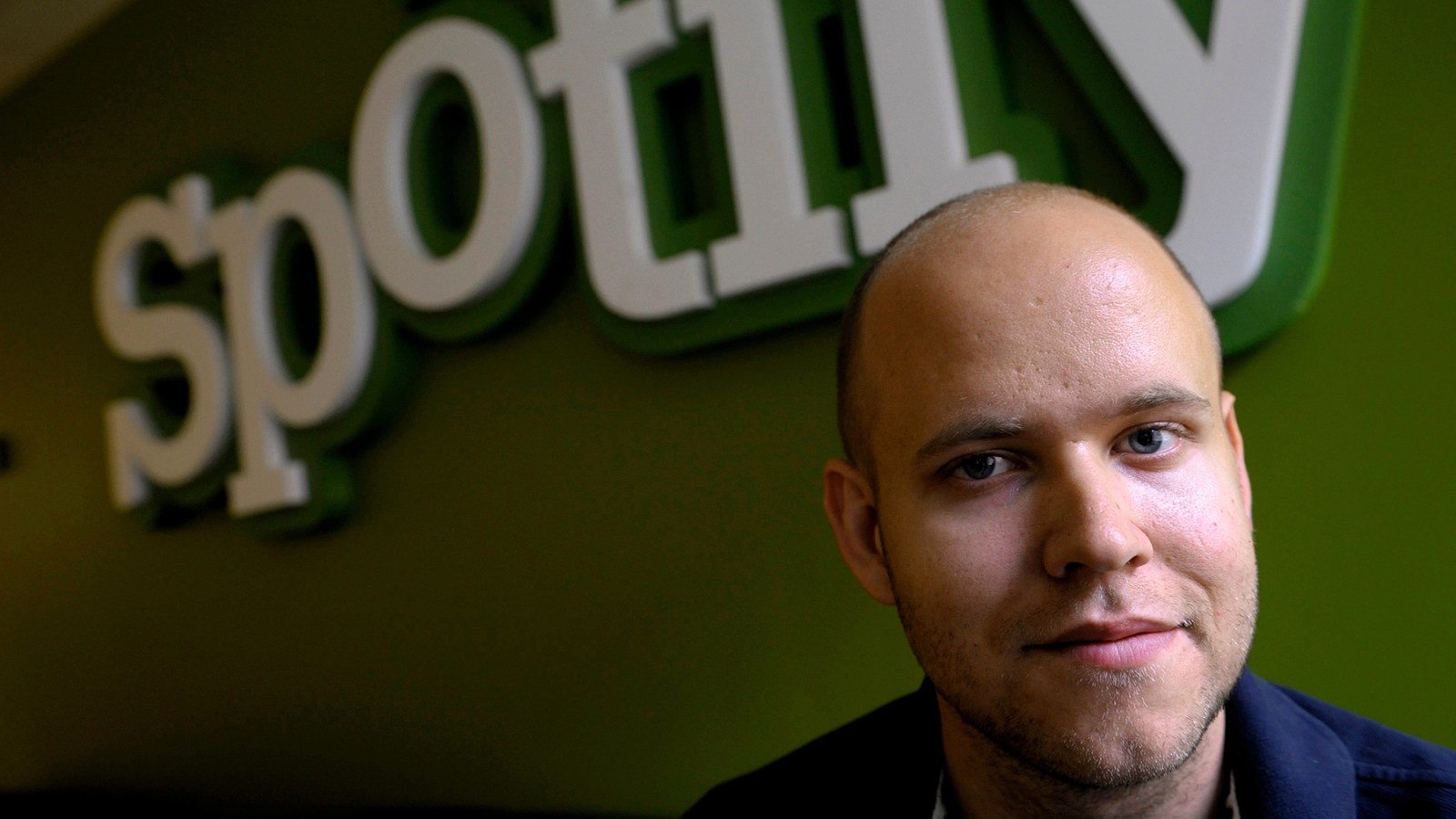Spotify launched in 2008 as a problem solver. Napster, the peer-to-peer music service that allowed users to download songs illegally, was in the rearview, and Apple’s iTunes stepped in to give legitimacy to a new consumption method: buying tracks. Music fans then, like in the decades before — spanning everything from wax cylinders to cassettes to compact discs — had ownership of their music collection. Artists and songwriters could earn a decent living with an album that sold even modestly. The charts reflected what was moving in stores, digital or otherwise. That all came to an end with the arrival of the Swedish streaming service.
Now comes the news that founder Daniel Ek is stepping aside from the CEO role he’s held since he was 23 years old “to focus on long-term strategy” as the company’s executive chairman (co-president and chief product and technology officer Gustav Soderstrom and co-president and chief business officer Alex Norstrom will serve as co-CEOs). A new era of the world’s biggest music company is sure to come, led by product and tech and less reliant on editorial, or the algorithm-assisted human curators compiling playlists.
Sure, Ek made renting music a very profitable business for himself — his net worth hovers at $10.3 billion, making him one of the richest people in Sweden — and for Spotify’s shareholders. He also helped resuscitate a record business being dragged down by the weight of its physical-product past, and slow to adapt to the speed of digital innovation. “The only way to solve the problem of piracy was to create a service that was better and at the same time compensates the music industry,” Ek told the Telegraph in a 2010 interview, a year before the app’s official U.S. launch.
To say Daniel Ek changed the music business as we know it is like suggesting the Gutenberg Bible disrupted the publishing business. Worldwide revenues from music nearly doubled from $13 billion in 2014 to $28.6 billion in 2024, according to the RIAA. From the mid-year 2025 results announced in September, paid subscription revenues were up to $3.2 billion, going over the 100 million subscriber mark in the U.S. for the first time (worldwide, Spotify boasts 300 million subscribers, Ek said in his announcement video). The overall streaming total of $4.68 billion represents 84 percent of the total revenue, with vinyl marking a nearly two-decade resurgence by accounting for $457 million in physical music revenues, topping CD shipments for the fifth consecutive year. Spotify’s payouts to the industry grew from $1 billion in 2014 to more than $10 billion in 2024.
Even so, musicians have widely called foul on numbers that come down to a minuscule $0.003 to $0.005 per stream, or just $3,000 to $5,000 for a million of them. Songwriters are even more incensed, having to split their declining earnings with co-writers and taking a backseat to the producers and rights-holders who are out for their own pieces of the pie. In recent months, artists have pulled their music from Spotify for any number of reasons. Popular Aussie band King Gizzard and the Lizard Wizard ditched Spotify in July to protest Ek’s investments in the military defense company Helsing, as did Xiu Xiu and Deerhoof. Previously, Neil Young and Joni Mitchell yanked their music off the service to protest Joe Rogan’s podcast at the height of the pandemic for supposedly spreading misinformation about the Covid vaccine. Artists including Massive Attack are also making a statement by insisting their music not be made available in controversial political arenas, like Israel, in light of the country’s protracted war in Gaza.
Spotify has transformed the way we listen to and consume music. No longer are we beholden to physical distribution — which has essentially wiped the large record retail chains from the planet, replacing them with an indie world of specialized mom-and-pops. But Bob Say, owner of Los Angeles’ Freakbeat Records, for one, isn’t all that bothered.
“Personally, I would say it’s a positive in terms of fans hearing music in-store,” says Say, who opened his Ventura Blvd. store in 2003, right as the digital revolution was in full swing. “We don’t get promos for new releases anymore. So, unless I want to open every record I want to hear, this is the only way to listen to new music. The biggest downside seems to be the inequity about what the artist earns from his work. Certainly a $15 a month subscription is a lot cheaper than buying two or three albums.”
For that subscription, you’re getting the world’s music library, but does it make sense that the company that rents music to you is worth more than the one creating it? Say what you will about a giant like Universal Music Group (which accounts for two-thirds of music consumption), but they’re the home and primary financial backer of once-in-a-generation artists like Lady Gaga, Eminem, Billie Eilish, and Chappell Roan, to say nothing of licensing partnerships with superstars including Taylor Swift, Rihanna, and Kendrick Lamar. Those are are big success stories. So how is it that everyone in this industry feels somewhat cheated?
Dr. Richard James Burgess is the outgoing head of A2IM (American Association of Independent Music), a post he has occupied for the better part of a decade, having worn any number of hats in the industry, including singer, songwriter, producer, composer, manager, marketer, and inventor. He points to Spotify as a missed opportunity for the music business, explaining how that industry has ceded both distribution and pricing to its tech partner.
Burgess explains that the recording industry’s sin was not going digital after the introduction of MP3 in the U.S. in 1996 (and the subsequent launch of mp3.com in 1997), a full two years before Shawn Fanning co-founded Napster with Sean Parker. At that point, the business forfeited its future to tech interlopers.
“There’s no question Spotify has been a major transformative force in how the industry operates, as much as I insist it still isn’t paying enough to artists,” he says, pointing out that today’s $17.7 billion in overall music-business revenue, compared to 1999’s $14.6 billion, is still substantially down in adjusted dollars for inflation.
Spotify has also hastened the demise of the album, as well as a world where the final product is used to promote the tour, rather than vice versa, alongside other pieces of merchandise like a T-shirt or poster. With less money being invested by record labels into touring, that has created a top-heavy artist hierarchy, with the rich getting richer and the poor and middle class falling by the wayside.
“Spotify has helped the recording side become a securitize-able asset,” says Burgess. “Many people have benefited from it. It’s difficult to separate the good and bad effects, considering the circumstances under which it was born when things looked grim. I don’t necessarily believe it’s grown the value of the business, but it did offer a solution to the piracy problem.”
Records have become a loss leader for a variety of different ancillary and touring opportunities, a tenuous situation for the traditional music business, which has seen its age-old model of providing tour support to promote music sales turned on its head.
“It’s a conundrum the labels are currently facing,” says Burgess. “When I was a musician, I made most of my money from records, not touring.”
In the end, it took a Swedish entrepreneur to hijack the worldwide record business, and the industry only has itself to blame.
“We can’t go back, we must continue moving forward,” Burgess concludes, looking at this brave new Spotify-led streaming world. “We should have gone digital when we had the chance, but the industry continues to be technophobic. We just missed the moment.”



